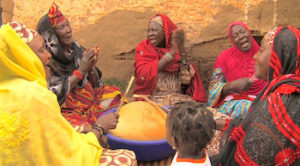
*The Zarma people are celebrated on this date in 1000. They are an African ethnic group predominantly found in westernmost Niger.
They are also found in the adjacent areas of Nigeria and Benin, along with smaller numbers in Burkina Faso, Ivory Coast, Ghana, Togo, and Sudan. In Niger, outsiders often consider the Zarma to be of the same ethnicity as the neighboring Songhai proper. However, the two groups claim differences, having different histories and speaking different dialects. They are sometimes lumped together as the Zarma-Songhay or Songhay-Zarma. The Zarma people are predominantly Muslims of the Maliki-Sunni school.
They live in the arid Sahel lands, along the Niger River valley, which is a source of irrigation, forage for cattle herds, and drinking water. They are relatively prosperous; they own cattle, sheep, goats, and dromedaries, renting them out to the Fulani people or Tuareg people for tending. The Zarma people have had a history of enslaved people and caste systems, like many West African ethnic groups. Like them, they also have had a historical musical tradition. Slavery has been a historical practice in West Africa long before the arrival of colonialism.
Niger and Mali are where the most significant Zarma people have historically lived and have their origins. There is textual evidence of a series of annual campaigns during the rules of Sunni Ali and Askiya Muhammad (Turé) to capture people as enslaved people, both for domestic use and export them to North Africa, mainly Morocco, Algiers, Tunis, and Tripoli. The 15th-century ruler Sunni Ali is an integral part of the legends revered by the Zarma people. The ethnic groups, including the Songhay-Zarma people, states Benedetta Rossi, stretching over the Sahel-Sudanese, have shared a political and economic system based on slavery from a pre-colonial period. The enslaved people were a financial asset, and they were used for farming, herding, and domestic work.
According to Rossi, the slavery system has been well developed and complex, where a system of social stratification developed within the enslaved people, and a master-slave status system survived even after slavery was officially abolished during the French colonial rule. The slave communities remain a part of memories of the Zarma people, states Alice Bellagamba. Colonial-era, The French colonial rulers came to regions of the Zarma people at the end of the 1890s, and the ensuing results of the Berlin Conference. This coincided when the chiefs and warlords within the Zarma society were in an intra-ethnic conflict. The French chose the Zarmakoy Aouta of Dosso as their partner and established a military post in what was then the village of Dosso in 1898.
The following period brought several natural disasters such as famines and locust attacks from 1901 to 1903. The French increased their presence during this period. The French relied on the Dosso military post and Niger river valleys to establish a much larger colonial zone in the Sahel to Chad. This led to conflicts and violence against the Zarma people that repeated the violence and tribute system imposed on Zarma. The French colonial rule established mines for resources in West Africa, such as along the Gold Coast, and these mines were staffed with African labor that relied mainly on migrant Zarma people. Thousands of Zarma people traveled to various French mines and built roads and railroads to connect significant sites of importance to the French rule.
This migrant labor followed the pre-colonial tradition of Zarma warriors heading to the gold coast for booty. Still, colonial mines provided economic adventurism. However, in many cases, migration was a means to “escape French economic exploitation.” Of the various ethnic groups in Niger, the early cooperation of the Zarma elite led to a legacy where Zarma interests have been promoted, and they have continued to be a dominating part of the political elite after its complete independence in 1960.
The estimates for the total population of Zarma people as of 2013 has been over 3 million. They constitute several smaller ethnic sub-groups, either indigenous to the era before the Songhai Empire and have assimilated into the Zarma people or are people of Zarma origins who have differentiated themselves sometime in the pre-colonial period. The Zarma language is one of the southern Songhai languages, a branch of the Nilo-Saharan language family. Because of the common language and culture, they are sometimes referred to as “Zarma Songhay.”